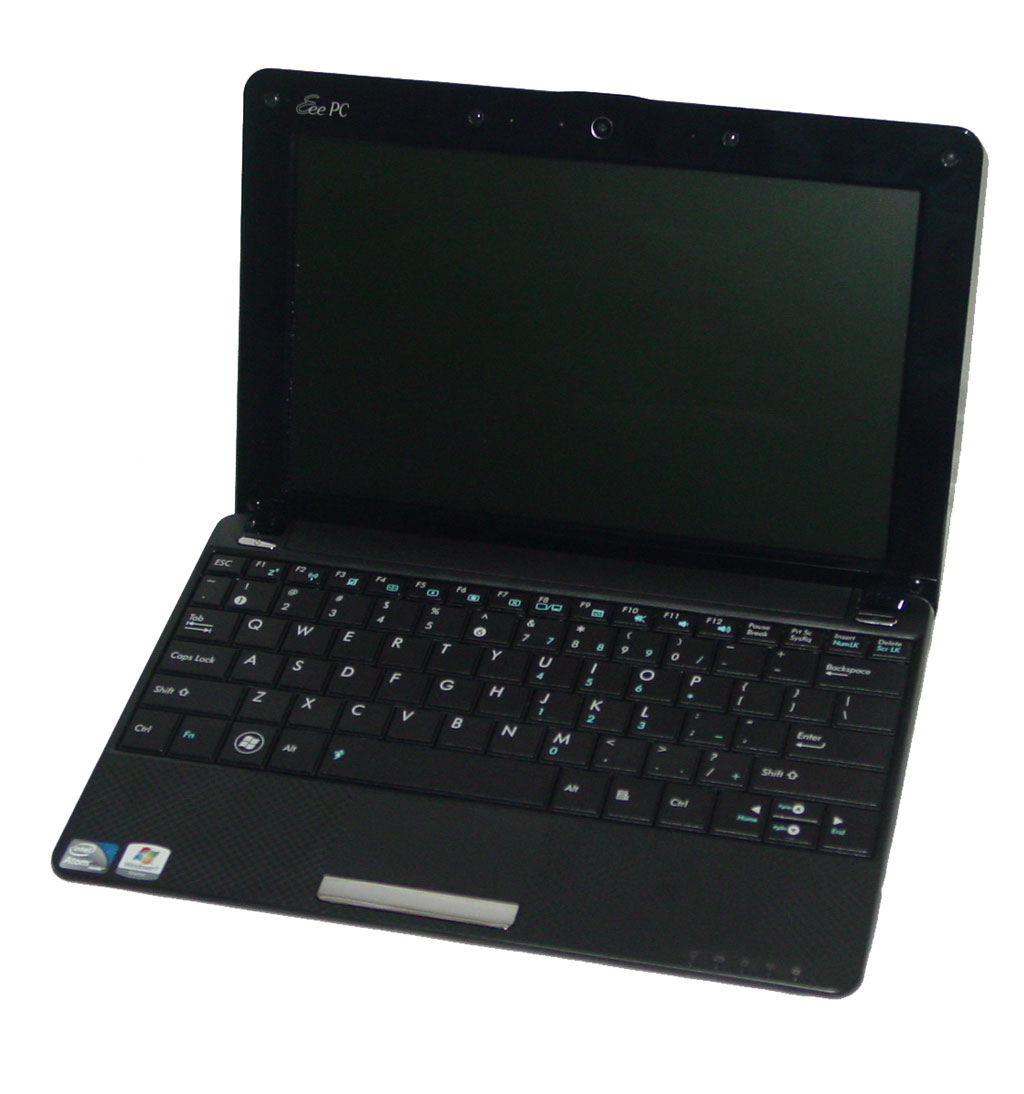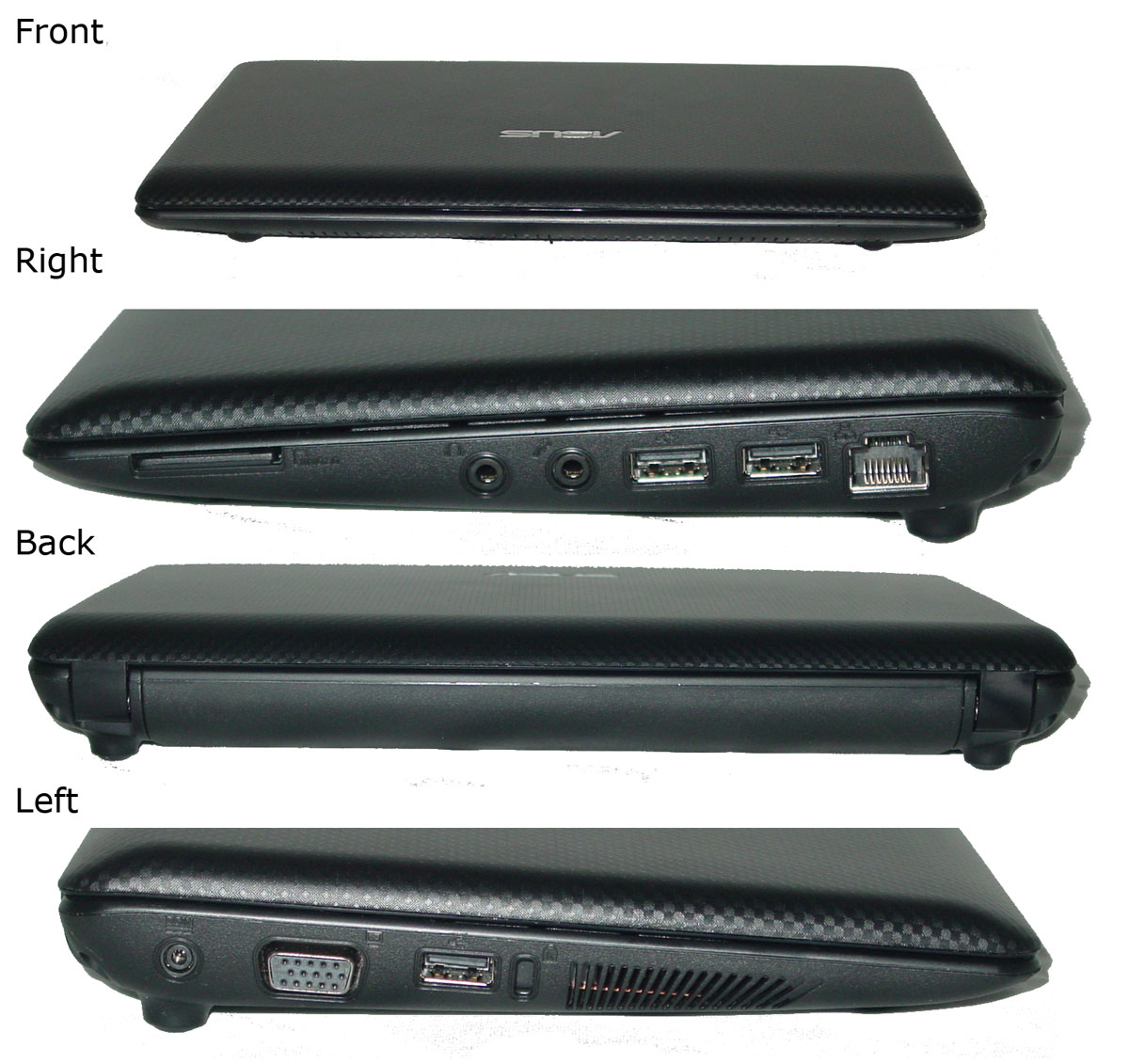Tom's Definitive 10.1" Netbook Buyer's Guide: Fall 2010
Asus Eee PC 1001P (1001P-MU17-BK)
From the original developers of the netbook, we have the 1001P Eee PC in the lab. This is basically an upgrade of the Diamondville platform on the 1005HA model from a while back.
It may be daunting to figure out which netbook to buy if you’re looking at the Eee PC lineup. Of the Pineview-based Atom processors, we count at least seven different 10.1” Eee PC models currently on the Asus Web site. However, this doesn’t even include the long list of submodels. For example, our $299.99 1001P-MU17-BK comes with a matte screen and Windows 7 Starter, even though the 1001P is listed with a glossy screen (Color-Shine) and Windows XP. Oddly enough, we can pick up a slightly cheaper $279.99 1001PX from Best Buy that has the same specs, but adds 802.11n support.
You need to know there is very little difference between Eee PCs at the internal hardware level; in some cases they share the same motherboard just with different processors. In fact it seems that between the seven different models, there are three motherboards designs.
The other differences between the submodels include:
- chiclet vs. traditional keyboard
- hard drive sizes
- 802.11n or draft-n support
- Bluetooth support
- 1.3 vs. 0.3 MP webcam
- DDR2 or DDR3
- touchpad style
- battery pack
- glossy vs. anti-glare/reflective
- case design
- different OS
- USB 3.0 support
- Port options
The 1001P lies at the entry-level of the Eee PC lineup, and shares the same case design as the 1001PX. There has been a lot of fanfare over this design because it looks similar to carbon fiber. Asus has never actually claimed this is a carbon fiber design, but other people have, and it snowballed from there. We should make clear this is a “carbon fiber weave design.” It is molded ABS that gives the texture of a carbon fiber weave surface. However, it is not carbon fiber.
If you look at the weight specification of this notebook and the price, they don't add up to even a CF composite. That aside, the weave texture gives the 1001P an excellent surface for gripping and hiding fingerprints. It is also important we point out that this texture doesn’t extend throughout the entire system design. It is only found on the display lid and the palm rests. The display bezel is a piano black. while everything else is the matte finish.
The keyboard on this particular version of the 1001P is the standard keyboard with which Asus basically started the Eee PC line. It has solid back support from the tray so tactile feedback is uniform. Note all Eee PC keyboards are 92% keyboards, but the large size of the keys here helps in the constrained space. If you include the beveled edges, the keys are the same size as those found on the 93% keyboard of the AO521 and LT2120u.
The touchpad is fairly unique. This is what Asus considers its standard Eee PC touchpad, despite the fact that it is fairly integrated into the surface of the casing. If you examine it closely, it seems as if the entire section was fabricated as a single piece. The touchpad’s surface, though, can be identified by the fact that the rest of the chassis has the “carbon fiber weave design.” This is another multi-gesture touchpad that has good feedback, but we have a minor complaint about the button bar, which makes using the touchpad sometimes tricky.
There is a very thin (~1 mm) border of the “carbon fiber weave design” that separates the touchpad from the touchpad’s button bar. The outline, in our opinion, is too thin to serve any purpose. When you are doing drag and drop operations, you hardly notice it, and as a result you can unintentionally lose tracking. Ideally, it should be edge-to-edge here.
The single rocker-style button is made of plastic with a metallic finish that sits slightly recessed below the casing. Our main complaint comes from the very shallow click we get. Separate left- and right-click buttons (instead of a single rocker-style design) aren't necessarily better, but there has to be good click depression and feedback for the design to work. There is good strong feedback, but the degree that the button goes down seems low considering that it is already recessed. This is exactly what makes it hard to tell if you are making a left or right click, unless you are doing so at the very far ends of the bar. If you click near the middle, there are two possible outcomes: either nothing happens or you achieve a click on a single side, depending on the angle. This is part of our complaint, because there is nothing that clearly separates the functionality. It is a minor annoyance, but hopefully we see an improvement in future Eee PC designs.
Current page: Asus Eee PC 1001P (1001P-MU17-BK)
Prev Page Acer Aspire One 521 (AO521) Next Page Dell Inspiron Mini 10 (1012 - HD Display)Get Tom's Hardware's best news and in-depth reviews, straight to your inbox.
-
frederico Very indepth excellent review. Pleasantly surprised. A lot of people out there have little clue of netbooks or even their uses. I got a little samsung last year and now I use it more than my main PC, obviously not for gaming, but watching webcasts/films at night, listening to music, grabbing it while watching TV to check something on the web, etc, etc. Not to mention completely essential when travelling on train/bus/wherever - 6 hours batt life still holding up.Reply
Very handy little things - easy to become addicted to. Theres some new models coming out this month that can handle HD but still have great batt life, will be tempted to pick one up.
-
ScoobyJooby-Jew I have used a Gateway netbook with vista and 2 gigs of ram. I loved it. The 2 gigs really helped smooth things out. And when I loaded the netbook distro of ubuntu, it was ridiculously awesome. It satisfied everything except gaming. Which is what I wanted it to do.Reply -
Luscious That's the best performance rundown I've seen to date on the Broadcom Crystal HD - nice to get critical, hands-on info without the marketing BS. That said, AMD's Nile platform is seriously spanking Intel.Reply
I recently tested the HP Pavilion dm1z with the dual-core K625. Only slightly heavier/bigger than the 10" HP 210 Mini, but far superior when it comes to performance:
http://lgponthemove.blogspot.com/2010/09/first-impressions-hp-dm1z-notebook.html -
lashabane Huh, never knew that a full propane tank weighs ~38 lbs.Reply
*Ninja edit*
Super good roundup/review. I'm in the market for a netbook this season and this review helped a lot. -
braneman I actually found that on my last netbook (toshiba satalite, amd based) with a ram upgrade the only game it couldn't play passably on lowest settings(resolution included) was red faction guerrilla, even then it was graphical errors, you could even bring Crysis up to MEDIUM on some settings. meh now I got an m11x, it's very nice.Reply -
KingArcher OMG this review is like drugs for the technically inclined.Reply
Good....no, Excellent job Andrew Ku. Amazing stuff. Really learned something new.
I look forward to reading more reviews from you. :bounce:
P.S. Editors, give this man a raise ;) -
super_tycoon If you're doing a 12 inch in the near future, I hope you include the Asus 1215n. I've had mine for three weeks and it's brilliant. ION2 and Optimus are easily worth whatever I paid for them. Playing any HD youtube video yields unicorns and butterflies while my friend's gateway (the one reviewed here) only gets the look of disapproval.Reply
My concern is that drivers for ION2 are a bit -fast- slow and loose now, the stock asus drivers were crap, the Nvidia update at launch was crap, but about two weeks ago there was a major update that requires manual installation. It gets roughly double, yes double, the fps of the old pos. Now I didn't write the thing, but it felt like it addressed the PCI-Ex1 link narrowness. (After all, what else could it be? It's just a 210m at it's core, but whatever's drawn on the Nvidia gpu also has to go back down the PCI-E link to be written to the Intel gpu vram (Optimus))
Anyhow, forget the broadcom thing, my friend (a different one, I promise they're real and actually have these things!) has the dell and it's pretty bad. Even I couldn't get that stupid thing to work reliably except for WMP. At least he got his with his new xps 16.
TL;DR I've actually used the gateway and dell netbooks reviewed here and they're both crappy. The gateway gets good battery life though and feels nicer. I love the asus 1215n with it's ION2 gpu and Optimus, and you should too.


